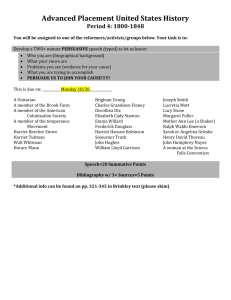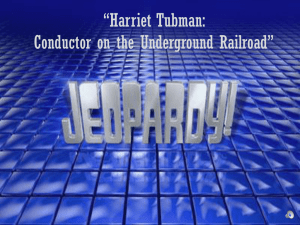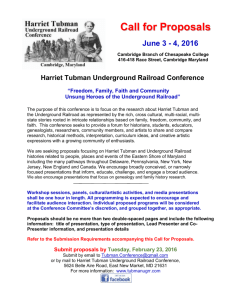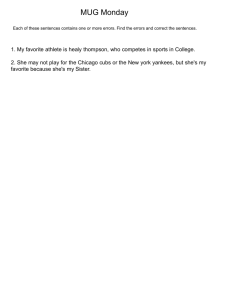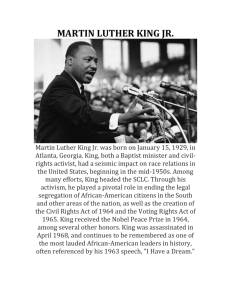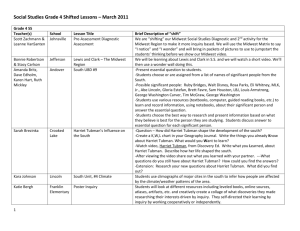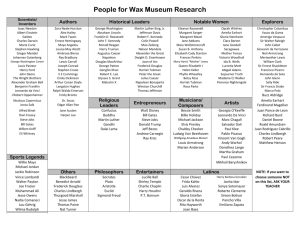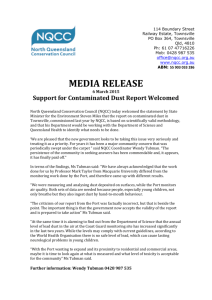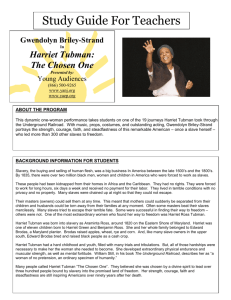Harriet Tubman DBQ Project
advertisement
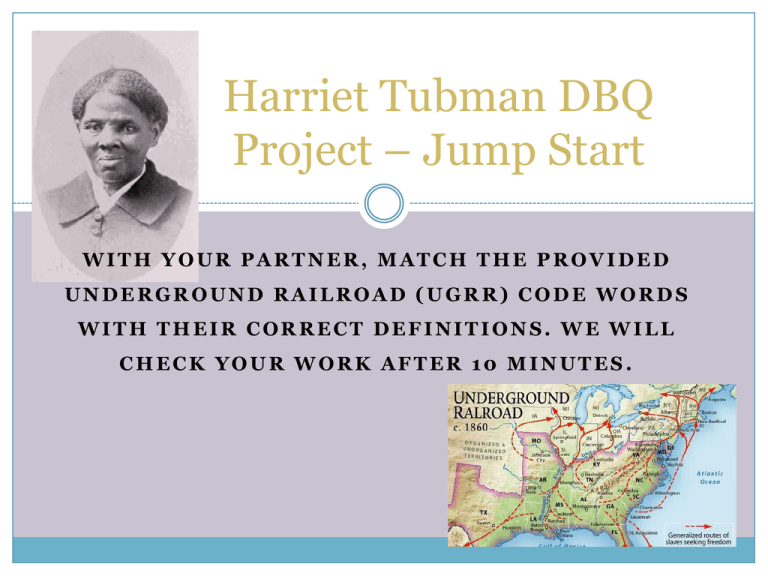
Harriet Tubman DBQ Project – Jump Start WITH YOUR PARTNER, MATCH THE PROVIDED UNDERGROUND RAILROAD (UGRR) CODE WORDS WITH THEIR CORRECT DEFINITIONS. WE WILL CHECK YOUR WORK AFTER 10 MINUTES. Underground Railroad Decoding Now that we have properly defined the UGRR code words, work with your partner to decode the following sentence: “It’s a long haul from Eqypt to New Canaan. With the amount of cargo on board, Moses will need a string of depots and at least two or three conductors to make it through.” If you finish early, try to write a coded sentence of your own! Jump Start - Background Essay Before reading the Background Essay, highlight the bolded words and define them in the columns surrounding the essay: Eastern Shore- the part of Maryland which lies to the east of the Chesapeake Bay Fugitive Slave Act- an act passed by Congress in 1850 which required Northerners to return escaped slaves Bloodhound Act- name given to the Fugitive Slave Act by angry Northerners Underground Railroad (UGGR)- name given to the secret network of people and safe houses that extended from the border states to Canada. Its purpose was to find a safe home for run-away slaves Background Essay Answer the following questions as you read the Background Essay. You should be able to answer in complete sentences: 1. At what ages and in what jobs did Tubman begin working as a child? 2. Explain what character traits Tubman might have gained due to her early life as a child slave (ex. Strong, Determined). 3. What fear did Tubman grow up with concerning her family? 4. In what ways might this fear have caused her to work as a “conductor” on the UGRR? 5. What caused Tubman to finally decide to try and escape? 6. Why, after 1850, did the UGRR not stop in the North but go all the way to Canada? 7. Would you consider her work on the UGRR as a great accomplishment? Why or why not? Understanding the Question Use your phone or a dictionary to define analytical The analytical question we are answering is: “What was Harriet Tubman’s greatest achievement? How would you define “greatest”? The following people have been considered the “greatest” by some at a point in history… George Washington Greatest? Agree or Disagree? Tony Romo Greatest? Agree or Disagree? Adolf Hitler Greatest? Agree or Disagree? Beyonce KnowlesCarter Greatest? Agree or Disagree? John Davis Greatest? Agree or Disagree? What does “greatest” mean? With your partner, brainstorm ways which we as a class could define the word “greatest” as it applies to Harriet Tubman’s life. Ex: The number of people each achievement help Make a list of at least 3 measures we can use. Be ready to share after 5-7 minutes. Jump Start – Document “A” Pick up a copy of Document “A” from the table along with a highlighter. Write your name at the top ASAP! Study the source information and the details of Document “A”. Is this a primary or secondary source? How can you tell? Be prepared to share out your answer! Achievements of Tubman Tubman is most well known for her work as a conductor on the Underground Railroad BUT that was NOT her ONLY achievement This DBQ asks you to decide which of the following was her greatest achievement using our working definition: 1. 2. 3. 4. Conductor on the UGRR- Documents A-B Civil War Spy- Document C Civil War Nurse- Document D Caregiver to the Poor and Elderly- Document E Review the chart provided. You will use this to record your evidence! Criteria Doc A Doc B Doc C Doc D Doc E #1 #2 #3 We will use this chart to keep track of the evidence we find in each document. Document “A” 1. Look over the ENTIRE document w/your partner. 2. At the bottom of your document, create a T-Chart. 3. Write 3 “THIN” observations. These are FACTS that’s you can state just from looking at the document. 4. On the other column, write 3 “THICK” observations. These are things you can tell but that the document does not state. 5. As a team, create a title for the document. 6. Discuss and prepare to defend what criteria it meets from your definition of “GREATNESS”. Document “A” Content Notes •Remember, the UGRR was a clandestine operation. Records are incomplete and data uneven. Estimates range from 30,000 to more than 100,000. •A large number of fugitives passed through Philadelphia. •An estimated 30,000 escaped slaves fled all the way to Canada. Most went to what was known as Canada West, which is now the city of Ontario. Jump Start – Document B and Story Board On the back of your packet, draw a 2x3 array or story board (2 rows w/3 columns). Begin reviewing Document “B”. Read all of it! Even the source and notes. Decide what type of source it is. Be ready to explain. What information does the chart provide? Document “B” You have the opportunity today to interview Catherine Clinton, biographer of Harriet Tubman. With your partner: 1. Read the ENTIRE document. 2. Study the chart and identify key information that is missing. Create at least 3 questions you would ask in order to accurately answer this week’s analytical question. Be prepared to share. 3. Create a title for the document. 4. Add document information to your chart. Document “B” Content Notes • Until recently, most textbooks stated that Harriet Tubman made 19 trips back down South. • However, she did not keep any written records and more current investigations suggests the # was fewer. • Her work on the UGRR is still remarkable because few agents accompanied slaves the entire trip as Tubman did, and no one did it with a reward on their head. • She received financial support from Abolitionists during that time and worked during the summers as a maid or cook. • She used this money during her abductions. Jump Start Find your packet from the table. Use your phone, a friend’s phone, or a Chrome Book to Google “Colonel Robert Shaw”. Create a “Top 5” list for why people SHOULD KNOW him on another piece of paper. Document “C” 1. “Listen Right” and draw what you hear in each section. 2.Compare your illustration with the document’s information. 3.Title the document “The Combahee River Raid”. 4.With your partner, continue your chart along with new information. Document “C” Notes Emma Telford was Tubman’s neighbor in New York. Harriet had arrived in Massachusetts to supply recently freed slaves w/clothing, schooling, and general support before she was approached by the Governor for the spy work. The raid was the first conducted by black troops serving in the Union Army after the Emancipation Proclamation. Harriet worked for the Union Army for no pay. She would serve for two and one half years in the Civil War. Jump Start – Simile Practice On the bottom of Document “C”, create a simile about Harriet Tubman that relates to your item from the “Mystery Bag”. Harriet Tubman is like _______ because ________. Be prepared to share out! Be creative! Check your evidence charts and make sure all boxes for A-C are completed. SILENTLY begin reading Document D. Document “D” 1. 2. 3. 4. 5. 6. Read the ENTIRE document w/your partner. Discuss and decide which account, Tubman’s or Bradford’s, provides you with more information to answer the analytical question. Be prepared to share. Create a TITLE for the document. What role does money play in the level of achievement in her work as a nurse? Add document information to your chart. Answer the document questions in complete sentences! Document “D” Notes The only book-length biography of Tubman was written by Bradford. It was written quickly to provide Tubman with some income to live off of. In the winter of 1863-1864, a son of William Lloyd Garrison found Tubman splitting her time between scouting for the army, gathering intelligence, nursing, and trying to make ends meet by cooking and washing clothes. Most money earned went to others. She became close friends with Secretary of State William Seward. Document “E” FACT INFERENCE QUESTION Things you can tell just by looking at the section of the photo. These are facts that can be pointed out in the picture. Things that you can infer about the picture using your background knowledge and evidence from the section. Things that the section of the photo makes you wonder. Your questions might be answered w/additional sections. 1. With your partner, STUDY each section of the photograph carefully. 2. Fill in the sections of the FIQ chart w/information. As sections of the photo are added, adjust your chart accordingly. 3. Create a TITLE for the document. 4. Add document information to your chart. Document “E” Notes Tubman received little money from the federal government even with many officials speaking on her behalf. In 1895, she finally began receiving $8 widow’s payment and $12 nurse’s pension. She never earned money for her work as a scout or spy. The Harriet Tubman Home was established in 1908 to fulfill her desire for what she cared for most— helping others. Her domestic work funded her many interests. Jump Start - Double Check Your Packet! Document A should have 3 THICK and 3 THIN observations. Document B should have 3 interview questions that could be asked of Ms. Clinton. Document C is your story board…is it done? Document D questions should be answered in COMPLETE sentences.
